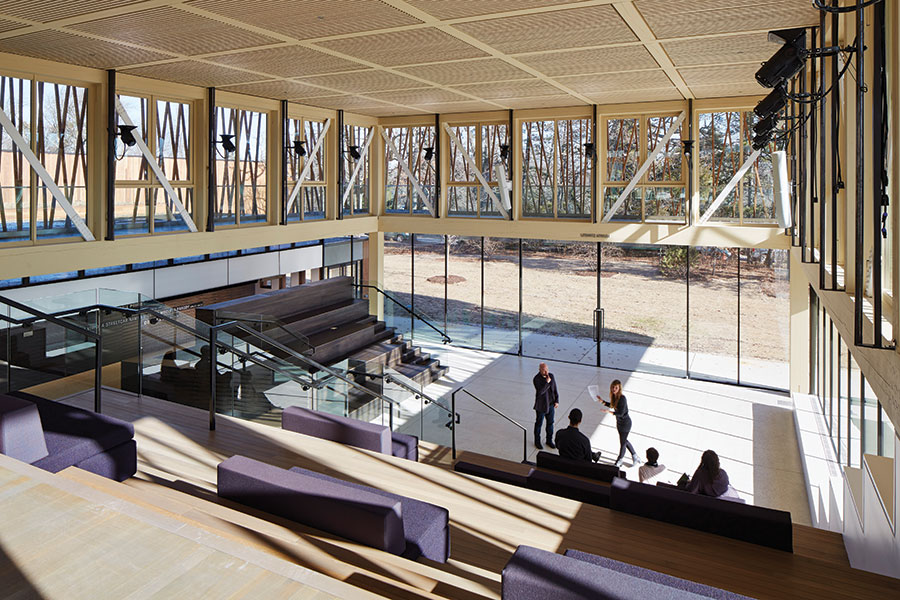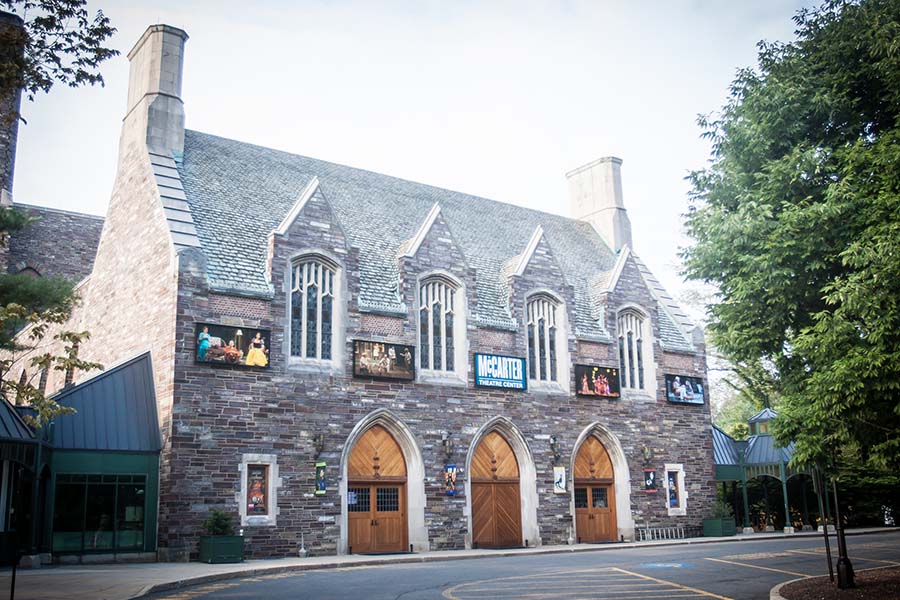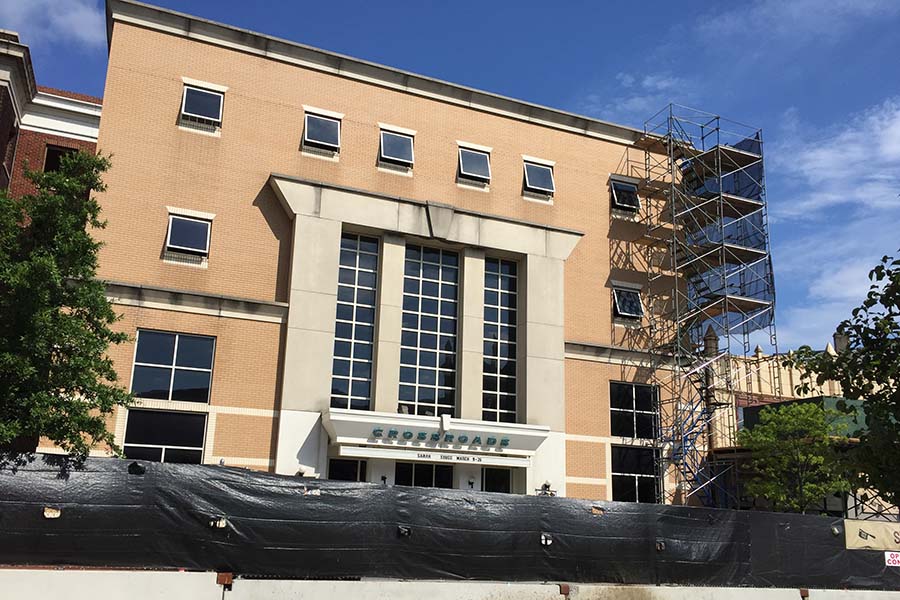“It’s coming down,” producing artistic director Marshall Jones III said casually in the Crossroads Theatre’s lobby last year.
“What’s coming down?” the patron asked.
“The building,” responded Jones. “It’s going to be torn down. I’m not sure when, but we’re going to be homeless for a while.”
The 26-year-old Crossroads Theatre Company in New Brunswick, N.J., along with the adjacent 33-year-old George Street Playhouse, is being razed to make room for a $215-million high-rise. The proposed 25-story tower will have two theatres similar in size to the old Crossroads and George Street, along with some rehearsal studios, a few floors of offices, and will be topped off by several levels of apartments.
To varying degrees, Crossroads and George Street have been involved in the planning of this new venture, called the New Brunswick Performing Arts Center. They vacated their buildings in the spring and will be displaced for at least two years, after which they will be renters at the new arts center. But Jones isn’t worried. “It’s a good thing,” he said. “George Street had outgrown their building. We are all optimistic that this will be a great opportunity for us to continue doing what we do in a new arts center that meets the needs of our audiences and artists.”
Crossroads, one of the nation’s premier African-American theatres, was founded in 1978. In 1991, Crossroads moved from its modest 120-seat theatre into the $4-million theatre facility built especially for them with funds raised by the New Brunswick Cultural Center. The facility was four stories tall and contained a 350-seat theatre, spaces for set and costume shops, rehearsal studios, and offices. Generous, right?
Be careful what you wish for. While Crossroads was the beneficiary of a brand-new theatre in which to operate, there were many strings attached, including the fact that it was obligated to pay market-rate rent and was responsible for the operations, utilities, and upkeep of the entire building. This crippled the small theatre company, and, shortly after it was awarded the 1999 Tony Award for outstanding regional theatre, it shut down with a debt of over $2 million.
Over the next several years, and with a lot of help, Crossroads’ debt was partly paid off and the rest forgiven. Jones was hired to resuscitate the company in 2007. After his challenging experience maintaining the Crossroads building, Jones is hoping that this new performing arts center will provide the support they’ve long needed.
For now, though, Jones is launching “Crossroads on the Road,” with productions at Middlesex County College, the New Jersey Performing Arts Center, and Rutgers University. George Street Playhouse, meanwhile, will be presenting its season in the former home of the Agricultural Museum of New Jersey on Rutgers’ Douglass College campus in New Brunswick.
“We are beyond thrilled that the New Brunswick Performing Arts Center is coming to fruition after 15 years of planning,” enthused David Saint, the artistic director of George Street. “Joseph Papp once said, ‘Theatres are like grapes—they grow better in bunches.’ I couldn’t agree with him more!”
Crossroads’ experiences raise the important question of whether it’s better for a theatre company to own or rent its facility. To help find an answer to that question, here’s a look at some ownership scenarios around the country, exploring the pluses and minuses of each option.

Reasons to Own
Owning your own building gives you control. You can set your own schedule without having to take into consideration potential conflicts with partner organizations or the whims of a landlord. Of course, you are then responsible for all the upkeep of your building, partly shifting a portion of the organization’s focus from theatrical production to property management. It may be a large price-tag but some theatre leaders believe that’s a relatively small price to pay for full independence.
Writers Theatre is one of those theatres. The 25-year-old company opened two new performance spaces under one roof in Glencoe, Ill., last year after completing a $33-million capital campaign to design and construct the building. The only complication is that the land the new theatre sits on is the property of the Woman’s Library Club of Glencoe, which owned the building that previously stood on the lot. WT now holds a 99-year lease on the land, for which it pays an annual rent of $1 to the club. In return, both organizations share the facility, with mutual benefits.
“The [club] members are very respectful of our schedule and happy to leave the maintenance and stewardship of the property to us,” says Writers’ founding artistic director, Michael Halberstam. “We were able to build our theatre center in the center of the village of Glencoe owing to the club’s trust and generosity, and the club has been able to boost membership as a result of having a gorgeous new home.”
By contrast, while the Wilma Theater in Philadelphia doesn’t own its building, and it is responsible for the property. The Wilma holds a 99-year lease on the theatre and the land, which are owned by a private developer.
“We are responsible for the maintenance and upkeep of the internal systems,” said managing director James Haskins. “Now that the building is 20 years old, we are facing the challenges of operating in an aging facility. A very significant way we are addressing these challenges is by transforming our lobby into a full-service café and renovating our facade.” In January, the Wilma announced a $10 million capital campaign to set up what they call a “Transformation Fund” that will allow for these and other upgrades.
“Having a space is both a dream and trap,” artistic director Blanka Zizka says. “Space offers continuity, but sometimes it becomes restrictive.” Yes, there is the comfort and routine of programming in one space, but it is also “demanding. It needs to be taken care of. It needs to be programmed. It has expectations. It asks for calendars and rules. Art asks for none of that. Art asks for learning, risk-taking, experimentation. Space needs to serve the art. But in many institutions, that notion gets turned around and art ends up serving the space.”

Reasons to Rent
Owning outright can be too expensive, time-consuming, and restrictive a proposition. McCarter Theatre in Princeton, N.J. produces its work in a 1930s-era building owned by Princeton University. It pays an annual nominal rent to the university. The university still periodically uses the building for special events, but McCarter operates independently as a full-service producing and presenting organization.
There have also been collaborations. When McCarter was constructing its 373-seat Berlind Theatre, Princeton provided 50 percent of the construction cost. In exchange, the university uses it in the fall and spring, for a total academic use of approximately 16 weeks.
“There are many benefits to running a theatre company from a university-owned building,” said Jeff Woodward, former managing director of both McCarter and Syracuse Stage, which operates out of Syracuse University in Upstate New York. “Even though McCarter had to raise its own money for renovations, a university is better equipped for building maintenance than a theatre company is. At Princeton, there was one guy whose only job was to fix doors!”
But one downside to renting is that at any point you may be out of a home. Huntington Theatre Company operated for 33 years out of a historic theatre owned by Boston University. Over the years, the free use of the theatre and cash contributions from the university have been estimated to total more than $40 million. But in 2015, Boston University announced its intention to sell the theatre and two adjoining buildings.
Huntington tried to buy the buildings, but the university accepted a higher bid from a local developer. After much public outcry and the strong support of Boston Mayor Marty Walsh, the new owners agreed to donate the theatre to the Huntington and give the company a 99-year lease on an additional 14,000 square feet for a new entrance and new public spaces in the high-rise they are planning to build adjacent to the theatre. The Huntington must now start a $60-million capital campaign for maintenance, restoration and improvements that had long been deferred by the university. So, again: a gift that is not without strings.
But in deciding whether to own or rent a performance space, managers should keep the theatre’s mission in mind, and consider one important question: Will the new venue help the organization to fulfill its mission, or will it impede it?
Having sloughed off the burdensome task of operating a theatre complex, Jones is looking forward to not having to think about property management in the future. “If you look at the building as the hardware and the plays as the software, I am more interested in the software, and the artists,” said Jones. “I’m not interested in fixing broken toilets. Managing a plant is onerous. The theatre was a blessing and a curse. In the new theatre, it will be a new era for Crossroads—the building will not be our identity. The work will be, and I welcome that.”
Lisa Lacroce Patterson, who has worked at the Wilma, McCarter, and Crossroads Theatre, is currently on State Theatre New Jersey’s development staff.


